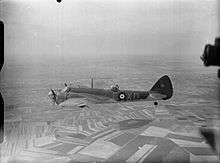No. 139 Squadron RAF
No. 139 (Jamaica) Squadron RAF was a Royal Air Force Squadron that was fighter unit in World War I and a bomber unit from World War II until the 1960s.
| No. 139 (Jamaica) Squadron RAF | |
|---|---|
| Active | 3 July 1918 – 7 Mar 1919 3 Sept 1936 – 31 Dec 1959 1 Jan 1962 – 31 Dec 1968 |
| Country | |
| Branch | |
| Motto(s) | Latin: Si placet necamus ("We destroy at will")[1] |
| Insignia | |
| Squadron Heraldry | A fasces in front of a crescent (The fasces is from the badge of No. 28 Squadron RAF to which No. 139 was first attached in 1918) |
| Squadron Codes | SY (Apr – Sep 1939) XD (Sep 1939 – Mar 1942, Jun 1942 – 1951) |
History
Formation and World War I
No. 139 Squadron Royal Air Force was formed on 3 July 1918 at Villaverla in Italy and was equipped with Bristol F2b fighter aircraft. It was disbanded on 7 March 1919.
Reformation and World War II

The squadron reformed on 3 September 1936 at Wyton, equipped first with Hawker Hinds and then Bristol Blenheims. On 3 September 1939 a Blenheim IV of the squadron piloted by Andrew McPherson was the first British aircraft to cross the German coast after Britain had declared war on Germany. On 4 September 1939, Nos. 110, 107 and 139 Squadrons led the first RAF air raid of the war against German shipping near Wilhelmshaven. In December 1939, the squadron was moved to Betheniville, France and in May 1940 when based at Plivot it was overrun by the German advance and lost most of its aircraft.
A Jamaican newspaper started a fund to buy bombers for Britain and in recognition of money raised to buy Blenheims it was decided to link Jamaica with a squadron of the Royal Air Force, hence the "Jamaica" tag given to the squadron. In December 1941, the squadron converted to the Lockheed Hudson aircraft, which it operated in Burma until April 1942.
In June 1942, the squadron returned to England and re-equipped with the Blenheim V before quickly switching to the de Havilland Mosquito at Horsham St. Faith. On 3 March, it carried out a daring air raid on the molybdenum processing plant at Knaben in Norway. It is believed that this was one of the raids on which the fictional work 633 Squadron was based. As a result of this raid a number of flight crew received decorations. On 20 March, the squadron lost a number of aircraft a week before the official announcement of the decorations.
It became part of the pathfinder force in July 1943 and remained so for the remainder of the war.
Post War
The squadron equipped with the English Electric Canberra B2 at RAF Hemswell beginning in November 1952. It disbanded on 31 December 1959 and reformed again at RAF Wittering on 1 January 1962 with the Handley Page Victor B2, before it was finally disbanded on 31 December 1968.
Aircraft operated
| From | To | Aircraft | Variant |
|---|---|---|---|
| May 1918 | Mar 1919 | Bristol F.2 | b |
| Sep 1936 | Jul 1937 | Hawker Hind | Mk.I |
| Jul 1937 | Sep 1939 | Bristol Blenheim | Mk.I |
| Sep 1939 | Dec 1941 | Bristol Blenheim | Mk.IV |
| Dec 1941 | Dec 1941 | Lockheed Hudson | Mk.III |
| Feb 1942 | Apr 1942 | Lockheed Hudson | Mk.III |
| Feb 1942 | Oct 1942 | Bristol Blenheim | Mk.V |
| Sep 1942 | Jul 1944 | De Havilland Mosquito | B.IV |
| Sep 1943 | Sep 1944 | De Havilland Mosquito | B.IX |
| Feb 1944 | Nov 1948 | De Havilland Mosquito | B.XVI |
| Nov 1943 | Sep 1945 | De Havilland Mosquito | B.XX |
| Sep 1945 | Sep 1948 | De Havilland Mosquito | B.XXV |
| Oct 1948 | Dec 1953 | De Havilland Mosquito | B.35 |
| Nov 1952 | Dec 1959 | English Electric Canberra | B.2 |
| Jan 1962 | Dec 1968 | Handley Page Victor | B.2 |
See also
References
Notes
- Pine, L G (1983). A dictionary of mottoes. London: Routledge and Kegan Paul. p. 213. ISBN 0-7100-9339-X.
- "Remembering the Bomber War". Aviation News. May 2005. Retrieved 3 January 2010.
- "Bristol Blenheim IV Aircraft History – World War Two Aircraft". RAF Museum London. Retrieved 3 January 2010.
- C.G.Jefford (1988). RAF Squadrons. UK Airlife Publishing. ISBN 1-85310-053-6.
Bibliography
- Moyes, Philip J.R. (1976). Bomber Squadrons of the RAF and their Aircraft. London: Macdonald and Jane's (Publishers). ISBN 0-354-01027-1.
External links
| Wikimedia Commons has media related to No. 139 Squadron RAF. |

